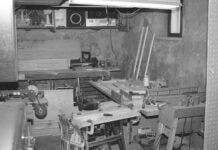The vise is one of the simplest machines ever invented. Yet, a Google patent search for “vise” returns more than 3 million hits. Included in those hits are vises for orthopedic surgery (called “bone-bending” vises—ouch!), ski maintenance vises, various pin vises and, naturally, scores and scores of vise designs for holding and machining odd shapes and sizes.
This 1950’s “baby” vise is reserved for light-duty tasks on small parts (the jaws are only 2-1/2 inches wide). Note how it’s lagged to a hardwood T-base. This allows the vise to be stored away and then clamped, as needed, to the woodworking bench.
Bench Vises
Bench vises come in small, medium, and large varieties, and there’s a wide range of quality available. To save cost, low-priced tradesman-style vises sometimes combine cast iron parts with tubular steel. High-end vises are either all forged steel or cast iron. Regardless of construction, a good vise is one where the movable jaw is not wobbly, where both jaws line up square and flush, and, if it has a swivel base, the swivel mechanism and hold-downs work smoothly.
Inexpensive tradesman-style vises like this are part cast iron, part steel tube construction. Note how the ram is exposed aft of the anvil.
This is a classic example of a swivel base, bullet-style machinist’s bench vise. The jaws are four inches wide. This might also be called a “combo” vise for the pipe-clamping, serrated V-jaws visible in the throat. Note also the vise is bolted to a solid three-inch-thick benchtop.
My friend Bryan Wood bought this massive vise on eBay for his racecar shop. He wanted it both portable and rock solid. The vise itself weights a whopping 135 pounds. The base is made of -inch thick, four-inch square tubing and is TIG welded. Bryan left an opening to fill the base with lead shot if it needed it (it didn’t). If taking two people to move it counts as portable, it’s portable.
Expect to pay a lot for a good bench vise: over $500 is typical, even for a used one. The reason is a good vise will last forever and, despite all the patents out there, the best designs, such as the classic Wilton “bullet” style, haven’t changed much in 60+ years.
You don’t have to bolt a bench vise to a bench. But that’s the usual way to anchor a vise. The importance of having a heavy, solid foundation becomes obvious the minute you start sawing, filing, or bending large or heavy workpieces. You don’t need a more demonstrable example of Newton’s Third Law than a wobbly bench.
Milling Vise
The key feature of the modern milling vise is the clamping wedge that forces the movable jaw onto the saddle of the vise. Prior to the introduction of this feature, the movable jaw, and with it the part being clamped, would have a tendency to ride up and off the saddle as the vise is tightened. This made it more or less impossible to maintain a reliable Z-axis (up and down) reference for production work.
Mill vises are typically attached to the mill with T-slot hardware. The base can be fixed or swivelled. The swivel feature is usually engraved with degree marks to facilitate angle settings. Mill vises, like bench vises, are typically sized according to the width of the clamping jaws and how wide the jaws open.
Typical mill vise with fixed base. In this case the vise is attached to a hold-down plate to allow positioning independent of the T-slots on the mill table. This vise has 4-inch wide jaws. The “speed” handle slides on and off the hex end of the clamping screw.
A large, six-inch mill vise with a swivel base and speed handle. It is fixed to the mill table with T-slot hardware.
A typical CNC-style vise, mounted on a Tormach Personal CNC machine. The vise is bolted to a fixture plate, which is fixed to the mill table with T-slot hardware.
Vises for CNC milling machines represent the best precision. Typically a CNC vise will not have a flange or any protruding bosses for fixing the vise with T-slots. The presumption is most CNC work is production oriented, so the vises are designed to be bolted directly to a fixture plate. By eliminating the flange, several vises can be ganged closely together for more efficiency.
Sine Vise
The sine vise is a specialty vise used primarily for tool grinding or other work that requires a precise angle setting. The concept is simple: two precision bars (aka sine bars) are positioned at a fixed distance in the base. The vise pivots around one sine bar while the other provides a tangent reference surface.
An example of an inexpensive (about $150) sine vise. This one sees more use on the welding table than anywhere else in the shop.
Using the center-to-center distance to calculate the spacing required to precision set any desired angle.
Sine vises used to be expensive, toolroom only items, but low-cost imports from China have made owning one downright affordable. In my shop the sine vise is used most often as a convenient angle-adjustable welding vise. It may be overkill for welding, but it sure is nice.
To set the vise to a particular angle, you can either use a calculator with trig functions, or an online sine angle calculator. The output number represents the distance from the sine-bar tangent to the base. The most precise angle settings require using gauge blocks, but if using it for welding or other makeshift jobs (as in not super precision), the sine vise can be set with a caliper, protractor, or digital angle gauge.























